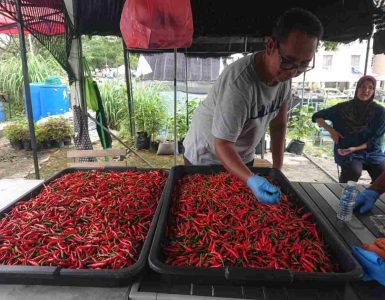
Incidents of sudden death due to hypertension are becoming more frequent and warrant serious attention, according to health officials.
But do you know what your blood pressure reading is? When was the last time you went for a medical check-up?
The questions may seem easy to answer, but many Malaysians above the age of 30 give nonchalant replies:
“I have never had a medical check-up.”
“I don’t have the time for a medical check-up.”
And, the classic, “I don’t know”.
Hypertension, better known as high blood pressure, is a silent killer.
Patients often show few symptoms until the appearance of chronic diseases such as stroke, heart failure, kidney failure and, eventually, death.
The World Health Organisation estimates that over one billion of the world’s population suffers from hypertension. This figure is expected to increase to 1.56 billion by 2025.
The National Health and Morbidity Survey (NHMS) in 2006 showed that the number of people afflicted with hypertension has increased to 41 percent from 33 percent in 1996.
The Malaysian scenario
In conjunction with World Hypertension Day on May 17, the Malaysian Society of Hypertension president, Dr Azani Mohamed Daud, said that sedentary lifestyles and excessive eating habits, now prevalent in society, are the reasons for the rising number of hypertension cases every year.
More worrisome is the fact that only nine percent of 4.8 million people with hypertension in Malaysia are taking steps to manage the disease.
“This is very alarming because it is a minute number compared to the number of people afflicted with hypertension. More worrisome is the low level of awareness in Malaysia, which stands at 35 percent. The figure is just two percent better than the 33 percent in 1996,” he said.

Everyone above 18 at risk, rural Malay women suffer most
Everyone above the age of 18, regardless of gender, is at risk of developing the disease, with the risk increasing as they age.
Dr Azani said that what needs to be highlighted from the NHMS is the fact that the number of women with hypertension is higher, at 43.4 percent, than men (41.7 percent).
“The Malays make up the largest number of hypertension sufferers in the country, compared to other races. Some 48.4 percent of Malay women suffer from hypertension, compared to Chinese (38.7 percent) and Indian (39.5 percent) women,” he said.
The survey also debunked the myth that city dwellers are more prone to hypertension. The findings revealed that more people living in rural areas suffer from hypertension, compared to those living in the cities.
Dr Azani said the survey showed 37 percent of hypertension sufferers live in rural areas,compared to 29.3 percent who lived in cities.
“There is a possibility that the consumption of salt-cured foods are thecause, especially salted fish, salted egg, “budu”, “cencaluk” and the like. However, the theory has yet to be proven.
“We need an in-depth study to ascertain why women who live in rural areas are more prone to hypertension. There are many unanswered questions and hopefully there are universities that will conduct a complete study on the subject,” he said.
What’s your number?
When the doctor places the black pressure cuff on the right arm and presses a silver disc on it, many nervously wonder if the numbers fall within the normal range.
Blood pressure is usually measured using a mercury or digital Sphygmomanometer, which is also known as a blood pressure monitor. It is usually measured while the patient is sitting or lying down.
The common readings are 120/80. The upper number, 120, is the systolic bloodpressure reading, which represents the maximum pressure exerted when the heart contracts (beats) and pushes blood out into the body. The lower number, 80, represents the diastolic blood pressure or the minimum pressure in the arteries between beats when the heart relaxes to fill with blood.
Both upper and lower numbers are equally important. However, studies showthat greater attention is paid to the systolic reading of those above 50 years old. This is due to the hardening of their blood vessels and the loss of elasticity, which puts them at risk for heart attacks.
There are a few levels of classification for blood pressure, which is categorised as optimal, normal and high. Optimal is normally 120/80.
Pre-hypertension happens when the upper numbers read between 120 and 139, while the lower reading is between 80 and 89.
The first stage of hypertension is when the upper number is between 140 and 159, while the lower number is between 90 and 99.
The second stage is when the upper number is between 160 and 179 and the lower number is between 100 and 109.
The third stage is the most dangerous. This is when the upper number is 180 and above, and the lower number is 110 and above.
High blood pressure occurs when the blood in a cardiovascular system flows at a higher pressure than usual, forcing the heart to pump harder than previously to ensure blood flow throughout the entire body.
“It is important to ensure that your blood pressure numbers do not exceedthe optimal level of 120/80. Therefore, regular check-ups are necessary.
“Hypertension sufferers need to manage their disease wisely because if it isignored, it can lead to a silent death caused by complications such as stroke, erectile dysfunction and kidney and heart failure.
Work-life balance is key
Blood pressure is important in ensuring blood flow to the muscles and important organs, especially the brain, heart and kidneys. However, if it is too high, it can destroy organs and ultimately, the arteries.
The condition can be exacerbated by a high cholesterol level, which can cause hardening of the arteries. The condition, called arteriosclerosis, contributes to organ damage.
Besides genetic factors, an excessive intake of salt, an increase of cholesterol in the system, obesity, excessive alcohol intake and an unhealthy lifestyle can also cause hypertension.
Pain in the back of the heart, heart palpitations, susceptibility to stress and blurred vision
Dr Azani said that a healthier lifestyle is best to prevent or manage hypertension since none of the symptoms would be present until a medical check-up is conducted.
Studies show that only 10 percent of hypertension sufferers exhibit symptoms such as pain in the back of the heart, heart palpitations, susceptibility to stress and blurred vision.
“How quickly complications manifest themselves depends on a person’s level of hypertension and whether or not they smoke, exercise or consume alcohol.
“Hypertension will not disappear, and in most cases, it can be classified asa lifelong illness with patients having to depend on medication to control it,” he said of the conventional medical wisdom.
He recommends exercising at least 30 minutes every day or 120 minutes a weekand ensuring that the Body Mass Index is at a normal level.
Avoiding pickled, fatty, salty and sweet foods, and abstaining from smoking, are also best for combating hypertension.
– Bernama











